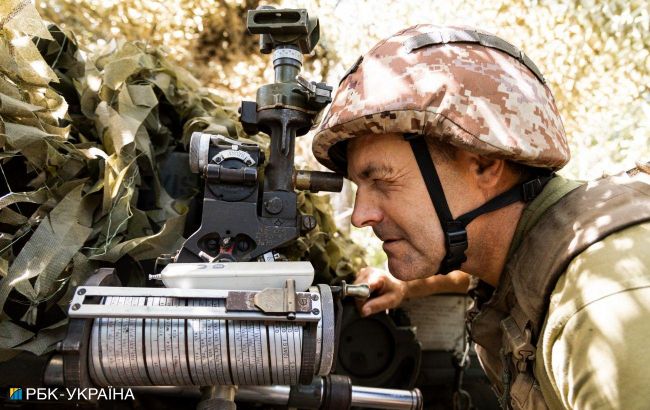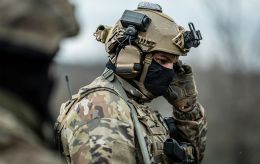Under KABs and drones swarms: How 31st Brigade fighters hold line in Pokrovsk frontline
 Ukrainian soldier (photo: Yevhen Symonenko/RBC-Ukraine)
Ukrainian soldier (photo: Yevhen Symonenko/RBC-Ukraine)
Pokrovsk frontline remains the target number one for Russian forces. The fiercest battles are currently taking place in the Donetsk region, with the situation described by the military as extremely difficult. Reporters spent a week at the positions of the 31st Mechanized Brigade (31 OMBr). More details are provided in the report by RBC-Ukraine war correspondent.
Contents
A brigade is a mechanism. The infantry cannot hold the defense without artillery support, which relies on aerial reconnaissance. War is complex and technological, but mastering this science has fallen to former civilians who made their choice and joined the ranks of the Defense Forces. RBC-Ukraine visited the 31st Mechanized Brigade positions on the Pokrovsk front and spoke with the soldiers about war, weapons, dreams, and victory.
Coffee amid explosions
Unfortunately, the Donetsk front greets us with the all-too-familiar and unpleasant sounds of explosions. Close to the road, guided bombs (KABs) hit, and thick smoke rises. The fields around have long been scorched by enemy fire.
"Camouflage is life" - a phrase we hear in nearly every unit. Keeping this in mind, we quickly hide our vehicle in the thickets so that the Russians' UAVs do not spot any unnecessary objects near the soldiers' positions. However, our troops sometimes deliberately leave decoys—fake weapons to distract the Russians from real equipment and positions. There's a fake weapon nearby.
A group of artillerymen meets us. They are middle-aged and older men, all former civilians. The commander of the howitzer, with the call sign Babai ("Boogeyman"), used to work in repairs, but for the past year and a half, he has been handling military equipment instead of repair tools. "I received a draft notice. They told me to go. If it's necessary, then it's necessary! Someone has to defend," he says.

At Babai's disposal is a 122 mm D-30 howitzer, which can hit the enemy at a distance of up to 15 kilometers. "The D-30 howitzer is very accurate. If not with the first shot, then with the second, after adjustments, it hits the target. It can fire up to 14.7 kilometers. But there are rocket-assisted projectiles that can reach 20 kilometers. We'd really like to have those," says the soldier.
At the beginning of his service, Babai was an aimer. He admits that the job was easier. As a commander, he must remember everything - how many shells were delivered and used, whether the aim is correct, and even whether the shell was brought on time and correctly.
His howitzer is designed to strike enemy infantry, but it can also destroy tanks and BMPs (infantry fighting vehicles). Thanks to the shockwave and shrapnel, it can "mow down" enemy personnel and provide fire support to our infantry.
"Our infantry needs to move in, but they can't. A forest strip must be cleared, but the trees are in the way. So we fire twenty salvos, and the strip is cleared—the Russians are left without cover, and our guys can move in and finish them off," Babai explains about his everyday duties on the front as if nothing out of the ordinary.
While the howitzer crew waits for orders, the soldiers invite us to enjoy coffee. The hot drink, made outdoors in an aluminum cup, tastes special. The atmosphere here is unique, too. We sit with the soldiers around a makeshift wooden table. Many of them are from Sumy, which is also suffering from Russian shelling. The men dream of leaving but say there's no time to rest.

Next to the improvised kitchen is a dugout that the soldiers call a house. They joke that it's almost a "luxury suite" for them - it has several beds and space for belongings. The conversation continues under the sounds of explosions - those same guided bombs (KABs) that continue to trouble them. For our defenders, this is the biggest problem. The Russians continue to use aviation, leveling everything around them.
As soon as the guys hear a command over the radio, they immediately jump up and run to the howitzer. Intelligence reported a gathering of enemy forces. The soldiers remove the camouflage from the equipment, and the crew prepares the shell. Meanwhile, the commander makes calculations. There's not much time - they must act before the enemy advances to new positions. A few shots - and the target is hit. We barely catch our breath from the sound of our own shells when we have to take cover from the enemy.
"Everyone to the shelter!" the commander shouts.
We quickly jumped into the dugout just as a heap of earth fell on us from the explosion wave. After firing at the enemy, the howitzer crew can also become a target, but we are again lucky - the shell hit a decoy.
This group of artillerymen has been on the front lines for over a year and a half. When asked about fatigue, they joke about it because they know they must keep working. And they all have the same dream. "We want this war to end. We want to hear 'Russia is surrendering! Go home!' over the radio instead of 'To battle!' But for now, there's silence, so we have to keep fighting," says Babai.
Filin's Dragon or how the Grad works
The positions of the rocket artillerymen resemble a small town. There are many different dugouts where the soldiers live, with the equipment located a bit further away. Another path leads to the improvised kitchen. The smell is incredible, as the cook had just made a huge pot of borscht before we arrived. Clothes are drying on lines, and nearby is another dugout - the "commander's office."
The commander of the Grad system, Filin ("Owl"), uncovers the equipment, calling it a dragon. The armored vehicle is adapted to new realities, equipped with several electronic warfare stations against FPV drones. They also have to hide from larger UAVs like the Lancet. The BM-21 Grad is mounted on a Ural-4320 chassis, the diesel version. Its firing range is 20 kilometers. It can fire an entire package of ammunition in 20 seconds.

Targeting is done with the help of reconnaissance drones. First, they calibrate the fire, and then the video allows them to adjust the shots. After precise targeting, the commander makes hand signals and gives the command - "Volley 333!" This is followed by a massive strike with a full salvo from the Grad.
"We deliver fire on enemy personnel and equipment columns and conduct counter-battery warfare quite successfully. We work regularly, keeping pace with our enemies, hitting them so that their assault units crouch instead of advancing at full height," says Filin.
After firing, the crew must quickly move away from the position. The sound of the Grad is so loud that the enemy immediately understands where the attack came from and will try to strike back.
The enemy uses a large amount of weaponry on the Pokrovsk front. The rocket artillerymen have to counter mortars, MLRS, and the same BM-21 Grad systems. The main task is to track assault groups and prevent them from reaching Ukrainian infantry positions.
Filin is convinced that this direction is a priority for the Russians. Their goal is to reach the Kostyantynivka-Pokrovsk highway to disrupt the logistics supply routes of the Ukrainian Armed Forces. The Defense Forces are holding back the advance, but the enemy has made progress in recent months.
"We need to keep delivering fire. And I think they're not invincible. They fall, they die, and in large numbers. Recently, we conducted a strike. We swept through their front line a bit. Everything was burning there, and they just threw away the bodies of their fallen comrades and moved on - they don't care about their fellow soldiers," said Filin.
The Kremlin leadership continues to send new reinforcements to replace the dead Russians. High salaries are still an incentive for citizens of the aggressor state to go and die on foreign soil. Despite the heavy losses, the Russians should not be underestimated, as they managed to achieve success with these assaults.
"The Russians call their assault units' pencils' because they break easily," the armored vehicle commander says ironically.
The enemy has powerful radar systems, particularly the Zoo, which is used to detect targets like artillery groups. "We are a priority target for the enemy because artillery remains the god of war. We punish the enemy with lightning speed!" assures Filin.

During the conversation, we hear a piercing sound. The signal comes from a small black device called Tsukorok ("Sugarcube"). A drone detector helps detect drones within the group's radius. Since the Russians are actively using unmanned aerial vehicles (UAVs), operating without such a device has become nearly impossible. Right now, Tsukorok signals that an enemy reconnaissance drone is flying nearby.
It is crucial to remain unnoticed; otherwise, the Russians could strike this position. In the "greenery," the soldiers are covered by trees and camouflage nets, but they still avoid making unnecessary movements.
FPV drones and KAB bombing
Before us is another village in Donbas destroyed by the Russians. In half an hour, dawn will break, so we need to reach the FPV drone group's position quickly.
People lived in this village until recently. According to the soldiers, livestock can still be seen here - cows, pigs, and chickens sometimes wander near the military positions. People couldn't take the animals with them when they left, so they would bring the soldiers chicken eggs as they departed.
Village residents often try to stay home until the very last moment. The sight of devastated villages and the destroyed houses within is heartbreaking. This was someone's home not long ago, but now it's a battlefield.
A UAV team has set up their workspace in the basement of one of the houses. At the entrance, jars of compotes prepared by the owners for the winter still stand, and next to them are drones ready for battle.
The radio is filled with constant chatter about the work at hand - other FPV drone teams are already engaged, and continuous surveillance is being conducted on the areas where the enemy is gathering.
"There's a tank, we need to take it out," we hear over the radio.

The guys quickly work to destroy the equipment moving toward the Defense Forces' positions. One soldier quickly prepares the drone while the pilot puts on the goggles and begins the flight.
Destroying enemy equipment is much harder now than before. The Russians are learning, and all their vehicles and tanks are equipped with electronic warfare (EW) systems that jam drones as they approach, using various frequencies for this purpose.
The Russians are trying to capture Pokrovsk, using tanks, BMPs, and infantry. Assault groups are transported in vehicles, disembark, and secure new positions. The soldiers are doing their best to counter this.
"Today, there was an assault - three armored vehicles were advancing, two BMPs and one tank. The BMPs were taken out immediately, but the other vehicles managed to get closer to us, and then they were destroyed," says FPV pilot Safron.
The man admits that the most challenging part of this war is when they are unable to repel an enemy attack - when equipment is heading toward our positions, but they can't reach it and destroy it. The Russians also have plenty of drones, quickly adopting Ukrainian tactics and mass-producing FPV drones themselves.
There are an extraordinary number of them on this front, so Ukrainian defense forces must constantly work to counter the deadly UAVs. The soldiers say that there are now so many EW systems with different frequencies that jam signals that, perhaps one day, no one will be able to fly - neither Ukrainian drones nor Russian ones.
The most terrifying and destructive weapon in this war is guided bombs. The Russians are constantly dropping them on the positions of the Ukrainian Defense Forces, literally turning the settlements of eastern Ukraine into ashes. The reporters from RBC-Ukraine had to experience the impact of a KAB bomb firsthand.
While talking to the soldiers, suddenly, we heard a sound - as if something was rustling and rapidly approaching. Another second passed, and then a loud explosion. The basement shook violently, sand fell on our heads, and everyone dropped.
"We're alive!"
The basement we were sitting in collapsed, and the exit was completely blocked with stones, parts of the door, and the roof. As we gathered ourselves, we realized how lucky we were - a KAB bomb had struck 50 meters away.

After digging out the exit from the basement, we saw the aftermath of the strike around us. The Russians are trying to destroy everything in their path, clearing the territory of people and seemingly of all living things. With horror, we realize how tough the battles ahead will be to prevent more cities from being reduced to ruins and captured by the occupiers. But just like the soldiers holding the defense, civilians have no choice but to accept this challenge and this fight.

